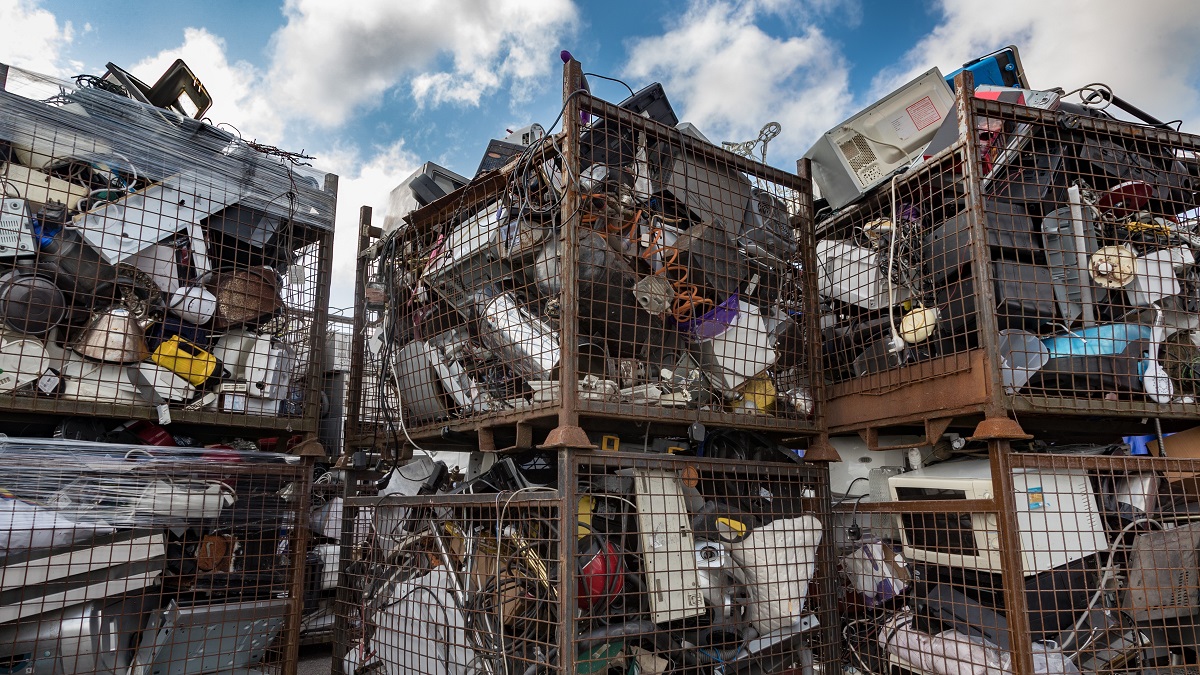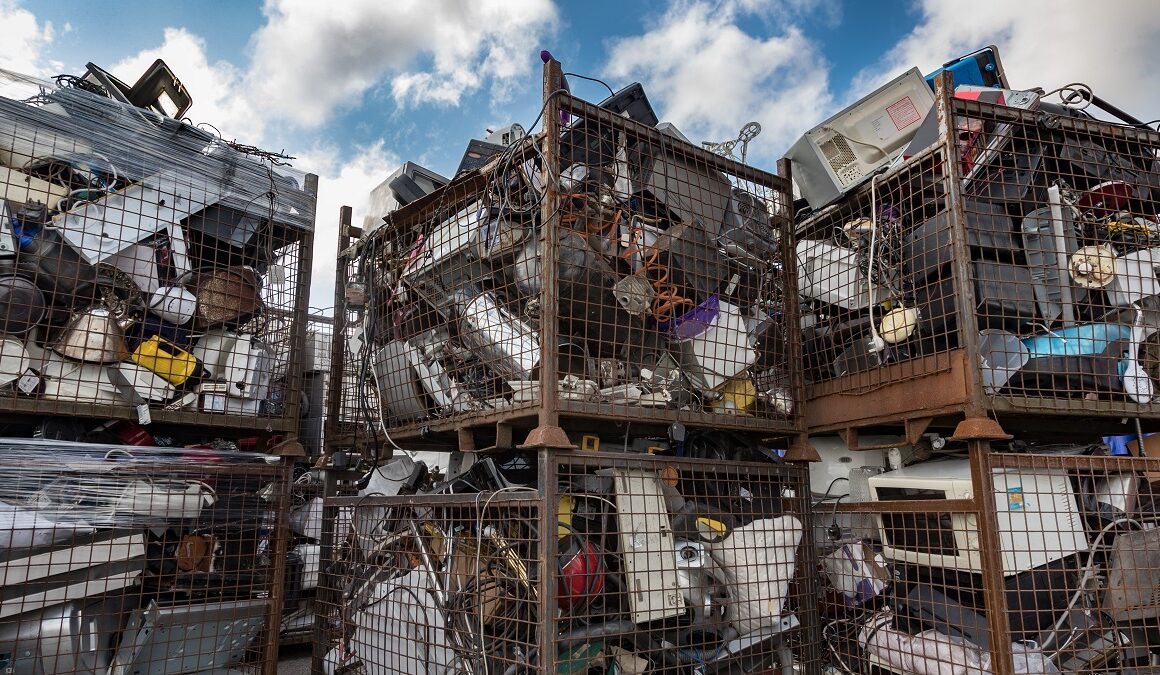What Happens to E-waste When It Gets Recycled?

Worldwide, electronic waste makes up more than 5% of all municipal solid waste. Commonly called “e-waste,” these discarded electronic products often end up in the landfill — but they shouldn’t. Some of these items can be repaired or reused if still functional. If they are irreparably broken, the e-waste should be recycled to reclaim reusable materials.
Cell phones, computers, TVs, DVD players, stereos, and printers are among the most common electronic products that can be refurbished or recycled. Others include microwaves, refrigerators, air conditioners, lamps, toys, video-game consoles, and power tools.
Recycling e-waste recovers useful materials — including valuable metals such as gold or copper — that manufacturers can use to make new products. This reduces the energy required to mine, refine, and manufacture new materials and reduces pollution and greenhouse gas emissions. The Environmental Protection Agency (EPA) states that by recycling 1 million cell phones, some 35,000 pounds of copper, 33 pounds of palladium, 772 pounds of silver, and 75 pounds of gold can be recovered. Amazingly, the United States loses $10 billion a year by tossing valuable e-waste into landfills, according to the Boston Consulting Group.
Moreover, 2024 estimates by the U.N. Institute for Training and Research show that only 22.3% of all e-waste is recycled internationally. In the United States, the average rate of recycling e-waste ranges between 14% and 40%, according to research published in Nature. However, most electronic waste still ends up in landfills or gets incinerated, wasting useful resources and releasing toxic chemicals and other pollutants — such as lead, mercury, and cadmium — into the soil, groundwater, and atmosphere to the detriment of the environment.
So, what exactly happens to e-waste when it’s recycled?
Exporting E-waste
In 2022, a record 62 million tons of e-waste were produced globally, and that volume will increase to 62 million tons by the end of the decade. The United Nations reports that the United States produces about 11.6% (7,188 tons) of the world’s e-waste and collects only 56% of the material at end of life. Of the e-waste that is recycled, much of it is first shipped abroad to separate the usable parts and extract the metals for reuse in new products.
For recycling firms in the United States or Europe, it is often cheaper to have the labor needed to pull apart and melt e-waste outsourced to nations such as China or India. Therefore, at present, some 50% to 80% of e-waste collected by recyclers is “exported.” The UN reported that China is the number one destination for exported e-waste, noting that an estimated 70% of the world’s e-waste ends up there.
Hazards of Electronic Recycling
The handling of hazardous and/or toxic materials poses significant potential health risks to workers employed in processing e-waste. Specifically, processes such as dismantling components, chemical processing, and incineration may all produce direct exposure to, and inhalation of, dangerous substances. One such common hazard is exposure to lead and other toxic metals. Another example of hazardous substance encountered in electronic recycling is mercury, which can be a dangerous neurotoxin.
If facilities lack adequate safety protocols, there is a constant risk of exposure to hazardous substances to workers as well as nearby communities. For example, the burning of wiring and cables increases the concentration of dioxins — toxins known to increase the risk of cancer if inhaled by workers or nearby residents. Likewise, dioxins can contribute to general air pollution.
In some developing nations, the people who work at these jobs have very limited economic opportunities. So, despite the health risks, the recycling industry is a welcome opportunity for employment.
How E-waste Is Processed
E-waste recycling is largely a process of separating plastics from metals and internal circuitry. Efficiency in this separation of materials is the foundation of economically viable electronics recycling because the e-waste stream must be processed in a way that separates commodities that can be used to make new products. As a result, the usual first step in e-waste processing is mechanically shredding products into tiny pieces.
Specific recycling processes vary depending on the materials being recycled and the technologies used, but there are some common steps. For example, at the recycling facility, workers may separate iron and steel from the waste stream on a conveyor belt with a powerful overhead magnet that lifts off the iron and steel so it can be prepared for resale as recycled steel.
Further mechanical processing separates aluminum, copper, and circuit boards. This leaves the material stream as mostly plastic. Often, water separation technology is then used to separate glass from plastics. The final step is locating and extracting any remaining metal from the plastics to further filter the material stream. The separated materials are prepared for sale as usable raw materials for the production of new electronics or other products.
The Economics of E-waste Recycling
IBISWorld estimated the revenue generated by the U.S. electronics recycling industry to reach almost $27 billion in 2024. Although the quantity of e-waste is growing fast, the quality of e-waste may be declining. Devices are becoming smaller and smaller, and therefore use fewer precious metals. In turn, the value of materials in many electrical devices has fallen drastically. Slumping global prices paid for recycled commodities have decreased profit margins and hurt electronics recyclers. Another obstacle is that many newer products are manufactured in ways that make it more difficult to recycle, repair, or reuse them.
At this time, 25 U.S. states have laws requiring statewide e-waste recycling. State e-waste recycling laws purportedly affect some 65% of Americans. Not to mention, in some states, the chief alternative to e-waste recycling — dumping electronic waste in landfills — is banned entirely.
Find out which organizations in your community help with recycling e-waste. Take advantage of online sources like Earth911 Recycling Search or Call2Recycle’s battery drop-off search to locate nearby options.
About the Author
Wesley Poritz is founder and owner of Big Sky Recycling. By harnessing the power of cell phones and electronics, Big Sky Recycling is dedicated to reducing e-waste and using profits as a means to a greater end: positive impact for our employees, communities, and the environment. Big Sky Recycling’s phone recycling program is a simple, secure, and free way to donate cell phones for charity.
This article was originally published on July 13, 2020 and updated with current data in August 2024.


